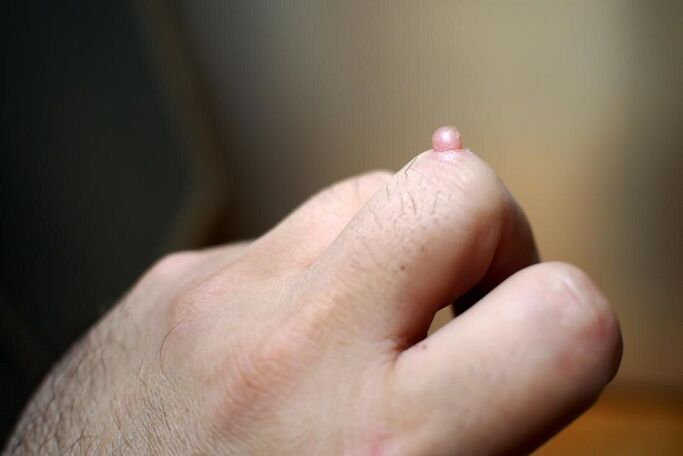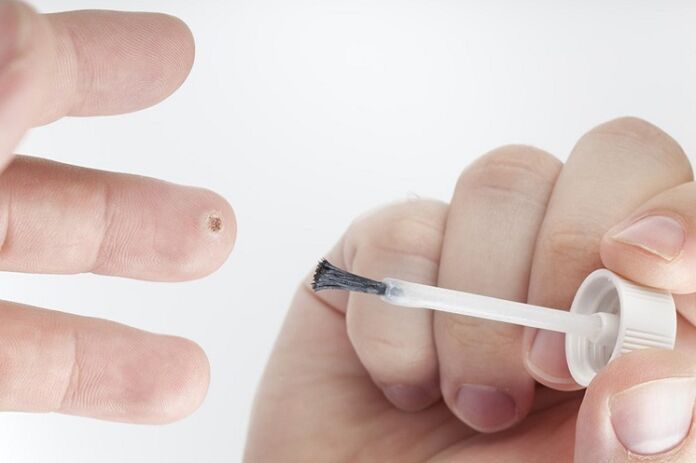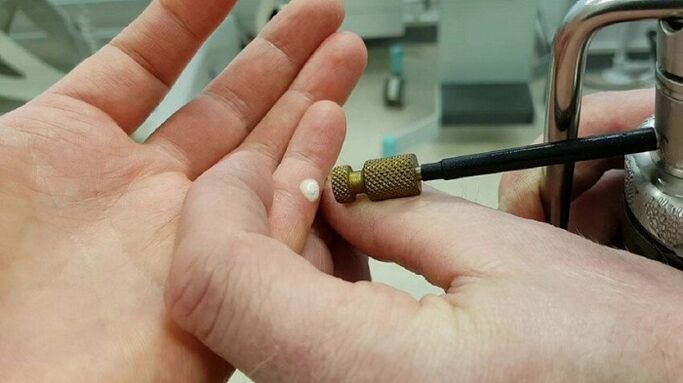Warts, as you already know, are caused by the human papillomavirus. They can be located on almost any part of the body, often showing warts on the hands. When are warts dangerous and require medical attention? How to prevent the appearance of warts on your hands? You will find the answers to these questions in the next article.

Warts on hands
A wart (verruca) is a benign infectious skin lesion that resembles a papule or papilloma.
Common and flat warts and genital warts are caused by a common virus for them - Tumefaciens verrucarum. The incubation period is long (2-5 months). Histologically, depending on the clinical form, there are different severity of papillomatosis, acanthosis, hyperkeratosis; in the cells of the styloid layer - perinuclear vacuoles.
Common wart (verruca vulgaris) is a dense, non-inflammatory nodule, from a needle head to a pea, grayish or yellowish with a rough surface. Most often localized on the hands. Common warts can occur in large numbers.
The wart is flat or youthful (verruca plana, p. Juvenilis) - a flat papule that protrudes slightly beyond the level of healthy skin, rounded or polygonal contours, flesh or yellowish-pink in color with a matte, sometimes shiny surface. Flat warts are usually more, poured out on the face, back of the hand in adolescents, mainly in school age.
Plantar wart (verruca plantaris) - a callus-like variety of a common wart - is located in places with the greatest pressure, mainly in the head of the metatarsal bone and in the heel area. Pain for pressure. After scraping the horny masses from the wart surface, papillary growths are revealed.
Genital warts (condyloma acuminatum) appear in the form of a small pink papule, then grow and take on a papillary shape. When papules fuse, extensive vegetation is formed. Characterized by a soft consistency, a narrow bottom in the form of a leg. More often develop on the genitals, in inguinal and intergluteal folds with impure maintenance and maceration of the skin.
Features of warts on hands and palms
Warts can affect absolutely any part of the epidermis in the hands, but most often they form on the back of the hand or in the area with the fingers. In addition, most of these formations belong to vulgar plants that do not differ in color from healthy skin and are relatively small in size - 0, 1-1 cm.
As for the number of such neoplasms, there are both single skin defects and multiple warts that are prone to fusion.
Particular signs of warts on the palms are the following manifestations:
- Lack of tenderness and itching;
- The site of the skin defect does not have an epidermal pattern, which is usually restored after removal of the wart;
- Black dots may appear on the surface of the formation, representing coagulated vessels.
Based on all of the above, we can conclude that warts on the palms are more of an aesthetic defect, which, however, in the absence of timely treatment can lead to a significant spread of neoplasms and a high risk of their mechanical damage.

How to recognize a wart
The wart looks like a mass rising above the skin, with a different color than the skin. Most often, several warts appear at once. At the same time, localization can be very diverse: from the palms and face to the soles of the feet (plantar warts). A wart can appear on the palm and even under the nail! The formation is hard to the touch, or conversely, smooth and flat.
The papillomas that appear in groups are capable of fusion.
Vulgar (common) warts usually appear on the fingers. A vulgar wart resembles a growth of no more than one centimeter in size, the color is brownish or gray and is dome-shaped. Black dots may be visible inside the formation. Flat small warts often appear on the hands and they are characterized by the appearance of the groups. Their color is pink or yellowish.
Reasons for the appearance
Warts on the fingers and other parts of the body are exclusively viral, which is associated with the penetration of the human papillomavirus into the patient's blood. Based on this, the treatment of warts on fingers, palms and elbows should aim to eliminate the underlying cause. Unfortunately, to date, there is no medical technique that is able to completely release the patient's blood from the virus, which rather explains the symptomatic treatment of neoplasms.
An important accompanying factor that causes the appearance of warts on the hands is a decrease in the body's immune response, which can occur due to overwork, malnutrition or an infectious process. Given the fact that HPV is able to enter the bloodstream through damage to the epidermis, it is worth noting the role of microtraumas, scratches and small wounds, which are not uncommon for the skin of the hands. Based on all of the above, you can again appreciate the importance of maintaining personal hand hygiene.
Despite all of the above, HPV infection is not critical. Statistical data claim that about 90% of all people are carriers of the virus, which may not manifest for a long time, being in the blood in a latent state.
As already mentioned, these neoplasms occur due to the penetration of the HP virus into the body, which has more than a hundred types. This virus is quite common, and common warts are found in twenty percent of school children.
It is important to remember that the attack multiplies quite intensively - through the germination of the upper layers. Additionally, the person you caught the "wart" virus may not have the warts themselves. HPV is particularly fond of microcracks in the skin and microtraumas, so most of them "bring" people from public pools and reservoirs.
If you do not take treatment and do not remove such rashes, complications can occur: they can spread throughout the body, and even if they disappear, they can return. When removing warts at home, keloid scars can form.
Symptoms of warts on hands and fingers
Of course, warts with all their innocence should not be ignored because they can cause quite a few problems. In addition, they are contagious and can pass on to new and new victims with a single tap.
By the way, the appearance of such rashes should be a reason to think about your own immunity, because it is people with impaired immunity who are at risk. Many strains weaken our immunity, and therefore such people also become open to such a virus.
How do we recognize a wart? Around the papilla or nodule that rises above the skin, the skin will be characteristically light or on the contrary dark. The bump appears more than one, usually on the forehead, cheeks, arms and legs, small warts appear, dense and fleshy, smooth and flat. Coarse growths appear around the nails or under the nails, and on the legs you can also feel such neoplasms that are oval or round in shape and that are painful to step on. When touched, they are slightly rough or smooth and flat, they can fuse in groups into a neoplasm.
The wart virus can linger in your body for years and the incubation period can last up to six months, so do not be surprised if they suddenly appeared for no apparent reason.
Warts can be different: there are vulgar or common, flat, plantar as well as filiform and genital. Common warts are those that appear on the feet and hands, on the elbows and knees and on the fingers and toes. These are small growths, no more than an inch, hard to touch, brownish or gray in color. Their shape is usually domed.
The surface of plain or vulgar can be rough, similar to cauliflower in appearance, and black dots can be distinguished inside. The flat type includes those that with sizes up to five millimeters are distinguished by a smooth flat surface as well as pink, yellowish or light brown in color. Typically, these growths occur on the face, but can grow in clusters on the hands or knees.
The most unpleasant are plantar warts: they cause many problems when walking, and cause sensations as if a pebble has gotten into a shoe. They are usually quite hard, dirty gray in color. The filiform type grows on the face - around the nose, on the neck, around the mouth. They are oblong and look like a finger in shape and color.
Warts also include genital warts, which are also called genitals: they develop on the genitals as well as in the groin and buttocks and are a direct consequence of an unclean attitude to your body. Externally, they look like pink nodules, often fuse together, have a base that resembles a leg.

When to see a doctor
- if the wart quickly changes shape, color or all;
- if the wart has an uneven color;
- if the boundaries of the warts are vague (in this case, it is probably not a wart);
- if the wart hurts or is constantly damaged (this increases the risk of its transformation into something more serious);
- if the number of warts gradually increases;
- if the wart bleeds or itches
How to get rid of papilloma on your hands
Warts cause us a lot of discomfort in everyday life. In conspicuous places, they do not look aesthetically pleasing; with inconvenient localization, they are quickly injured and cause pain. That is why people very often go to a dermatologist when warts appear. Because of the possibility of their malignancy, oncologists are also involved in warts.
Since the occurrence of warts is associated with provocative factors, treatment is often supplemented with intake of vitamin-mineral complexes, sedatives and immune-boosting agents. Otherwise, mechanical removal of papillomas may not give the desired results, and after a while they begin to grow again.
The desire to get rid of warts on your own sometimes leads to bad consequences. Different folk remedies offered by different counselors can not only avoid removing the wart but also contribute to its malignancy. You have to be extremely careful here. Treatment of warts at home should not involve the use of traditional medicine, but the use of special drugs purchased at the pharmacy.
It is even easier to trust the professionals from private clinics. Or make an appointment with a dermatologist, an oncology pharmacy.
Methods for papilloma removal
Today, private and public clinics can offer a fairly wide range of methods for removing warts. Before choosing a removal technique, listen to your doctor's recommendations. Your doctor will advise you on the most appropriate intervention based on your individual characteristics. These are especially:
- Cryodestruction. . . Assumes the use of liquid nitrogen to destroy the papilloma. Nitrogen is applied to the wart, usually with an applicator, and the formation freezes for fifteen to twenty seconds. To date, applicators have been developed that are easy to use at home. They can be purchased at a reasonable price at pharmacies.
- Electrocoagulation.Cut the papilloma with a thin metal loop under high frequency current. Local anesthesia is performed before surgery. Complete healing occurs in one week.
- Laser coagulation. . . It is similar to electrocoagulation, only one laser is used instead of current.
- Surgical procedure. . . Under local anesthesia, the wart is excised with a scalpel, the site of the surgical wound is sewn with a cosmetic suture. It is used only for the removal of large papillomas.
- Chemical methods. . . They are used extremely rarely as the risk of damaging nearby tissues is too great.

What to do to dissolve warts on the hands
A woman's son was only four years old when warts began to appear on his arms. There were so many of them that in kindergarten the mother was asked not to even take him there. And what they just did not do with this accident! Doctors recommended burning the warts with acid. But the woman still decided to turn to folk medicine for the treatment of warts.
Cut a branch of a thuja (the size of a palm) into pieces of 3-7 mm. Put in a vial, for example hydrogen peroxide, pour alcohol. Close with a stopper and let it brew for 12 days, shaking occasionally. After 12 days, open and keep the bottle open for 1-2 days. Then the tincture is ready for use.
You need to dip a cotton ball on a matchstick in it and lubricate the warts several times a day. It is recommended to lubricate up to six times a day. And after such a treatment, the warts finally began to disappear from the boy's skin without a trace. However, do not expect immediate results. So when the course of treatment for the boy was quite long. And by the way, the tincture can be stored for a very long time.
Propolis for warts on the fingers
For a very long time - over six years - a woman could not get rid of a wart on her finger. She tried to burn it out with liquid nitrogen, but the wart continued to grow. She even went to the oncologist because she had already begun to believe it was a malignant neoplasm.
But at the hospital, her fear was not confirmed and the doctor suggested she take a piece of propolis the size of a wart, put it in her mouth and soften it with saliva. At this point, in a little warm water - clean, without additives - hold a finger with a wart for 30-40 minutes so that it also softens. Then wipe your finger and apply propolis on the wart, which is just softened in the mouth.
It should be secured with tape for three or four days. It was written in the lunar calendar that it is best to start removing warts during the full moon and continue until the new moon.
The day before the new moon, remove all bandages and stop treatment until the full moon and start again at the full moon.
It was with such a folk method of treating warts that she painlessly got rid of this unpleasant accident. If you have smaller warts, you may be able to get rid of the warts in a full moon for new moon treatment.
Prevention of warts
It is known that it is easier to prevent disease than to cure it later. This is fully true for warts. First of all, you need to follow the basic rules of personal hygiene.
You should not walk barefoot in common areas, especially wet areas - eg showers, changing rooms, swimming pools; do not abuse such shoes where the feet are constantly sweating, or at least find an opportunity to dry them qualitatively; Do not unnecessarily touch your own or others' warts or objects that the patient touched with you.
You should also pay attention to your general health and especially the immune system - eat a balanced diet and lead a healthy lifestyle.
It would also be nice to learn how to relax and avoid stress - by doing this you are guaranteed to avoid not only the possible appearance of warts, but also a whole lot of possible diseases.














































































